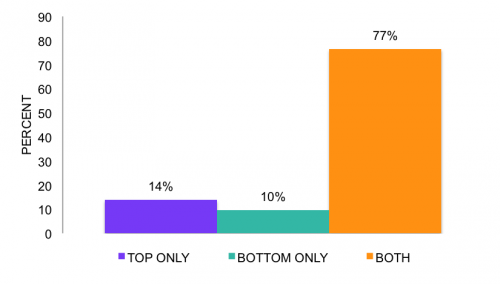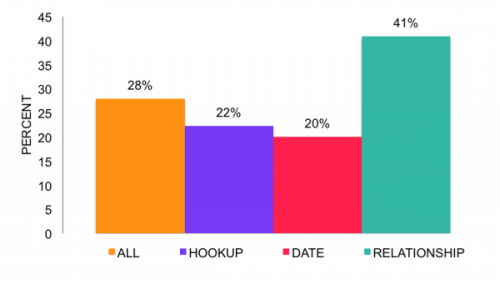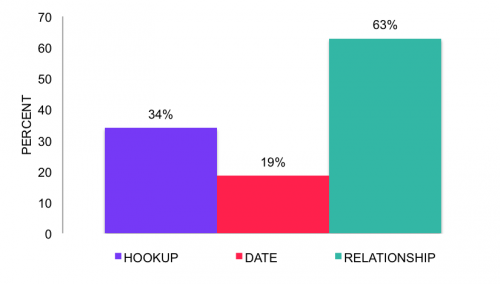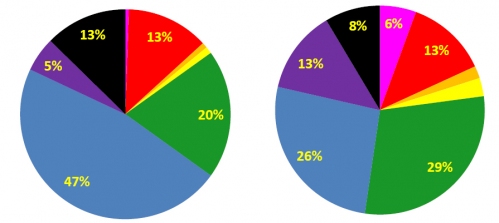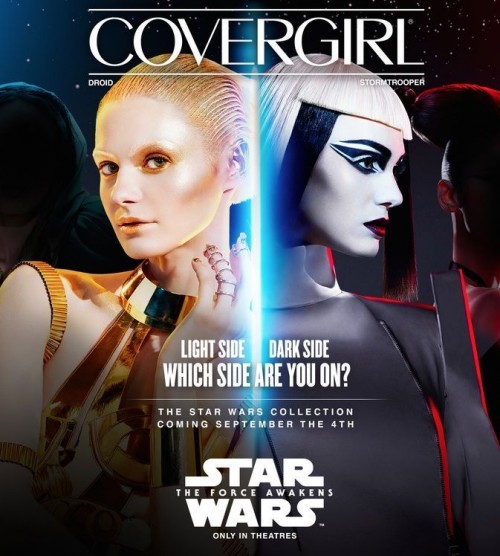Cross-posted at Center for Love and Sex.
The Director of Center for Love and Sex, Sari Cooper, had the wonderful idea of doing a Q&A exchange. I recently wrote a book about sex in college, American Hookup, and she works as a therapist with young people in their post-graduation romantic and sexual relationships. I was curious to hear about the issues that millennials are grappling with once they get out into the working world and begin to date, and she wanted to hear more about my research regarding the state of hookups on campus. So, we swapped questions and agreed to cross-post our answers.
Sari Cooper interviews Lisa Wade
Given that hookups have been criticized in the larger American culture and media for some time now, I thought I would begin our conversation on a constructive thread. What have you found are positive emotional. psychological and physical outcomes/by products reported by young adults engaging in hookups during their college years?
Most students arrive on campus eager to experiment with casual sexual contact, even if just a little. They see sexual activity as a natural part of being human, are increasingly tolerant of a wide range of sexual orientations, and largely reject the idea that it’s okay to judge sexually active women more harshly than men. Thanks to the women’s movement, the sexual revolution, and gay liberation, the stigma of sexual activity has largely lifted.
In that environment, many young people enjoy “first times” — first kisses, first blow jobs, first one night stands — and honing new sexual skills. Many find it exciting to be participating in a part of life that is new to them (puberty was just a few years ago and 50% are virgins when they arrive on campus). It’s pleasurable to indulge one’s desires, to do new things, and to improve, no less with sex than with anything else in life.
Hookups offer these things to young people and, for a nontrivial minority of students, hookups are everything they want. For up to a quarter of students, hookups are incredibly gratifying. Research shows that students who claim to thrive in hookup culture really do: the more they hookup, the higher their self-esteem and sense of well-being.
What intersectionalities did you find in your research regarding status in terms of desirability with racial, gender and LGBTQ culture? When research is done is it mostly skewed towards white, cisgender heterosexual sexual behaviors?
Students of color, women, and non-heterosexual students report more dissatisfaction with hookup culture and hooking up less than their counterparts, as do students who grew up poor or working-class. Non-heterosexual students often find that hookup culture is indifferent or hostile to their sexualities, so some avoid the hyper-heterosexualized spaces of hookup culture. LGBTQ students, especially if they are men, are much more likely to seek hookups off-campus.
Students of color simultaneously face a white supremacist standard of attractiveness and the possibility of being eroticized as “exotic.” This tends to play out differently for different kinds of students. Black men and Asian women are often fetishized, while black women and Asian men are often actively avoided. On average, then, white students hookup more than nonwhite students.
The other thing that I have found interesting in my work with clients is the vague aspect of the term hookup. How did your research subjects define hookups? And what behaviors were more frequently engaged in during hookups on campus?
Students generally agree that any sexually charged activity can count as a hookup, so long as there is no expectation of future sexual or romantic interaction. In practice, 40% of hookups include intercourse, 12% include only what we might call foreplay (nudity and some touching of genitals), 13% proceed to oral sex but don’t include intercourse, and 35% don’t go any farther than kissing and groping.
What were the most common emotions young people stated they experienced during and after a hookup?
Two psychologists -– Elizabeth Paul and Kristen Hayes -– asked students what emotions they thought their peers felt when they were in the midst of a typical hookup. Their respondents listed emotions as wide-ranging as excitement, embarrassment, regret, fear, anxiety, confusion, and pride, but the most common answer—mentioned by two-thirds of their sample—was lust. The next most common answer, though, wasn’t any of the other emotions listed, it was “nothing,” the absence of emotion. So, students tend to believe that their peers are feeling turned on, but not much else.
Of course, in practice students are experiencing all kinds of emotions — positive and negative, strong and weak, wanted and unwanted — but when they do they often feel bad about it. Believing that their peers are much better at having “emotionless sex,” they feel like they are failing at hookup culture.
What percentage of your study opted out of hookups entirely? Did you have numbers on whether these young people remained celibate, and/or chose to be in longer-term relationships that involved emotions?
A third of students opt out, reporting zero hookups at graduation, but many of these students don’t end up in relationships instead. On college campuses today, most relationships form out of a series of hookups. Students hook up together once, then twice and then three times, and eventually they start breaking the rules of hookup culture (they begin to like each other and say so). At that point, students will often go on dates and consider beginning an emotionally committed relationship. For students who aren’t willing to hook up, this can’t happen, so relationships can be elusive.
Lastly, what percentage of those that participated in hook-ups reported being in the following states:
- had had some alcohol,
- felt drunk
- had had no/minimal alcohol
- completely sober
Most students are at least a little bit drunk when they hook up because inebriation is a primary way that they signal to one another that what they are doing is meaningless. Being drunk is a sign that they are being careless, both about what they’re doing and who they’re doing it with. Sober sex, in contrast, is heavily weighted with meaning. As one of my students explained: “[If you are sober] it means you both are particularly attracted to each other and it’s not really a one-time thing. When drunk, you can kind of just do it because it’s fun and then be able to laugh about it and have it not be awkward or not mean anything. Many of my sexually active students, then, had actually never had sex sober.
Lisa Wade interviews Sari Cooper
Many parents are worried that their children no longer value emotional closeness, committed relationships, or building a family life. Should they be worried that they’ll children will choose never to marry or have children?
This is a many-layered question. I actually think once young adults are out in the working world for a few years, some of these millennials are yearning for a close intimate relationship because they see how much they need the comfort and consistency of an ongoing partner. In my practice Center for Love and Sex, we see people in their mid to late twenties and early thirties who are either seeking a meaningful, emotionally close relationship or those that are already in a committed relationship but need help. But the meaning of commitment to this age group may look similar or different to their parents. In other words, some couples are committed to one another as primary bond partners but choose to have a non-monogamous agreement, or decide not to marry or decide to marry but live in different cities while building their careers.
I think parents need to ask themselves what value they place on their children having children, is it a desire to be a grandparent and have that experience, or is it that they think it’s the religiously, or traditionally correct thing to do? I have found couples who have discussed their desire to have children before getting married while also working with couples who are figuring out what neighborhood to live in together without discussing
a) what moving in together means in terms of their commitment to the relationship, or one another or
b) seriously whether each person is aligned with the other around having children in their future.
Lastly, I think many of the college-educated millennials I see in my practice are so focused on their careers that having children may be put on the back burner. These are the couples I see later on in their life when they have trouble with fertility and going through infertility treatments, or have children one right after the other and are struck by the huge toll raising small children while keeping up with both of their demanding jobs has on their romantic and sexual connection.
What kind of sexual culture are young people out of college encountering? Is the hookup script still powerful? Is the dating script? Is monogamy still the assumed frame for emotional commitment? Or have polyamory and open relationships gone mainstream?
For those millennials who have gone to college, the first few years on their own may still include hook-ups or casual dating as they are spending more time on establishing themselves professionally and/or living on a modest salary with their parents or roommates. However, the dating is pretty commitment-free and at times frustrating for those looking for a relationship since much of the app-driven “dating” is texting with someone for weeks on end before actually meeting. Some reasons might be that the texting over weeks provides a person with the banter or insight as to whether they actually want to devote time to an actual date (the equivalent of talking to someone at a bar or party for a while before asking or getting asked for a phone number). However, either while this chat-texting is going on the person may “ghost” you, that is, they may just stop texting back. While this no-show experience would happen in the pre-cell phone days, the “ghosting” may also occur after people have dated a few times, perhaps hooked up or even had intercourse together. The person being ghosted becomes more and more skeptical of what real attachment can really be gained from their next “match”.
I find that people don’t begin dating seriously till their later twenties. Monogamy is still the assumed frame of emotional commitment once the couple has had “the exclusion talk”. However the millennial cohort seems more open to talk about having alternative arrangements monogamy-wise. Navigating this agreement is a presenting issue with which couples come in to CLS to get help negotiating since they recognize it can bring up jealousy and are not sure how to establish boundaries that will work for both partners. While I don’t think it has gone mainstream, I do think that traditional agreements are being questioned.
Students say that the skills and strategies for negotiating hookup culture are essentially the opposite of the skills and strategies they need for negotiating committed relationships. After graduation, when students seek out more meaningful relationships, do you find that they struggle with emotional openness, closeness, and risk-taking?
I find the skills needed to develop relationships in the early stages are a bit different than the ones later on so I’ll answer these questions separately. I think because so much time in college is spent either opting out of the hook-up culture or participating in it usually under the influence of alcohol, emotional vulnerability with someone to whom you are also erotically attracted hardly ever occurs. However college students usually develop close platonic friendships.
Some of these friendships can even develop into love relationships later on. However, they may never have been erotically attached to these partners. So some of these young adults may know how to be good partners, considerate roommates, and love one another but there is very little sexual fizz in that occurs. These couples come in as they’re about to become engaged, get married or decide to have a baby. They are what I call companionate couples and they are open about most everything except their sexual desires and so they are not having much if any sexual contact at all.
Since they haven’t had a lot of practice negotiating compromise over long periods of time, if someone does meet someone with whom they have sexual chemistry, they don’t know how to manage day-to-day conflicts like:
Can you shower before you come on to me?
Do you expect me to walk the dog every day you’re off on this bachelorette trip?
Why are you not saving more money?
If they haven’t developed constructive communication skills, these conflicts can head south quickly and then they may look at their partner and wonder where did my erotic attraction for them go? They may get scared and end the relationship before understanding that to get back into their erotic groove requires patience, openness to listen and practice empathy to come to a connection again. Hookups don’t help in the sustaining enough patience to feel like you’re going to come through it to the other side and find your partner attractive again.
If they do, is this something to be overly concerned about? Do they learn these skills effectively despite their experience (or lack of experience) in hookup culture? Or are they inhibited from doing so in a way that they wouldn’t have been had they not adapted to this new college context?
I would say that they’re just starting later and need more practice at the integration of emotional intimacy and sexual connection since they have begun later. For a portion of these millennials, their life online has become more primary to their face-to-face relationships or dates. Whether it’s swiping right or left as a self-esteem sport to see how many matches one gets, or masturbating to porn which doesn’t require expertise, courage to make mistakes or consideration of a partner’s needs/feelings, some young adults prefer to remain on their own as a protective expression against vulnerability, performance anxiety or rejection.
Do students in committed relationships struggle specifically with sexual intimacy? Some of my students worried that the imperative to make sex “meaningless” would later interfere with their ability to experience it as “meaningful.” Acts of tenderness — like cuddling, prolonged eye contact, and gentle kisses — are off script in hookup culture; many of my students had never experienced those things, despite being sexually active. Is it challenging for them to learn how to incorporate tenderness into their sexualities?
This is a good question. I should preface the answer that sexual intimacy is like beauty, it’s in the eye and body of each individual. I think that acts of tenderness can be challenging for some, especially if you’ve spent years compartmentalizing your emotions from your sexual practices. After the novelty of a relationship dies down, a couple really does need to dig deeper to find out what kinds of sexual activity they like and how they become able to enter the erotic zone. One can’t rely only on intrinsic horniness because for many reasons (stress at work, lack of sleep, hormone changes) this may not be as regularly available. So learning to practice intimacy (which is unique to each person) and relaxation as an entryway into erotic connection are skills that people can learn. It may feel awkward and uncomfortable at first (remember the first time you French-kissed?), but with practice incorporating emotional intimacy (which may or may not include some of the acts you described) into sexual connection can gradually feel more syntonic.
What is some of the most important advice that young people need to hear? If you could get a message to each and every young person transitioning out of college, what would it be?
I would say to the millennials to educate yourself about your erotic triggers to increase your Sex Esteem®. This education can be gleaned from this blog and the following sites: my webshow Sex Esteem® with Sari Cooper, Columbia University’s site Go Ask Alice, and the vast list of sites on Dartmouth University’s site, Gay Men’s Good Sex Guide, and the following books: Guide to Getting it On, Sex For One, She Comes First, The New Male Sexuality, Come as You Are, and SexSmart.
Sari Cooper, LCSW is a licensed individual, couples and AASECT-Certified Sex Therapist. She specializes in working on issues such as sexual disorders, sexual avoidance, couples communication, affairs, separation, depression, anxiety, and alternative sexual interests. She is the Founder and Director of Center for Love and Sex.
Lisa Wade, PhD is a professor at Occidental College. She is the author of American Hookup, a book about college sexual culture, and a textbook about gender. You can follow her on Twitter, Facebook, and Instagram.




